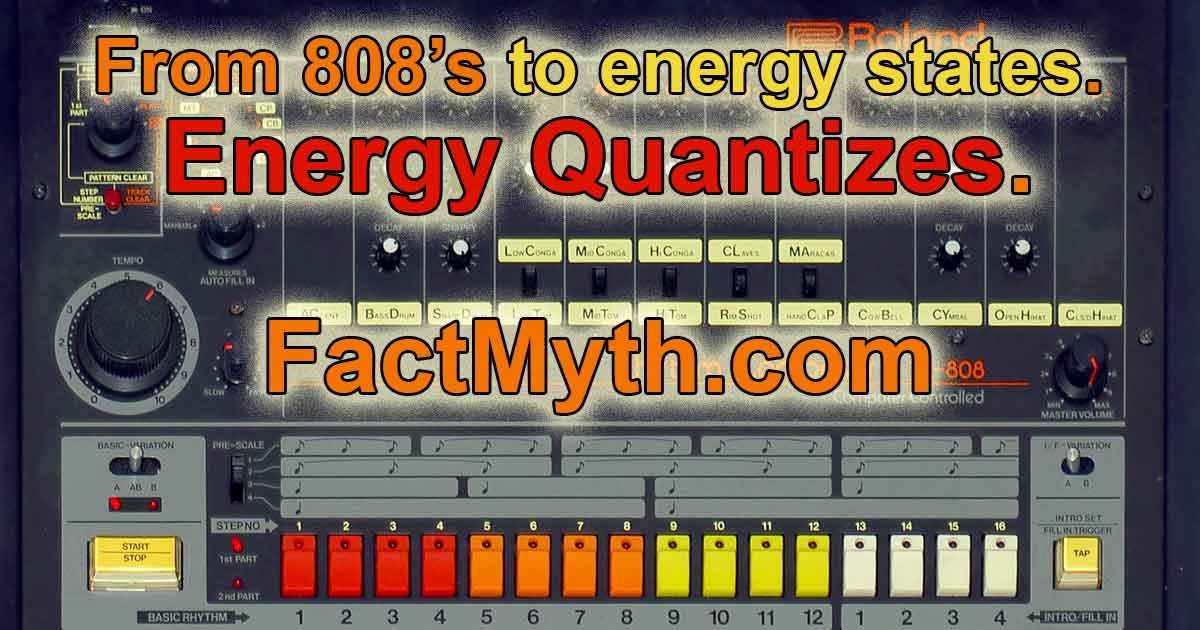- “Quantized Energy (Planck)“. Kentchemistry.com. Nov 24, 2015.
Quantization is to Restrict Something to a Set of Values fact

What Does Quantize Mean?
To quantize is to restrict something to a set of values. In digital music notes can be quantized to beats, in physics energy is quantized energy states.
In simple terms, when something snaps into place, it is quantization. Whether it happens in electronic music, or with electrons circling around an atom, when a value that should be a continuous variable is restricted to a discrete set of values, we call the process quantization.
The concept is the same for an 808 step sequencer, as it for quantum particles. In fact, the concept of particle behavior quantizing to energy states is where “quantum” physics gets its name.
Bottom line: Nothing involving energy is continuous, everything involving energy is quantized (snaps into place in little jumps), and this concept is easiest to understand by looking at a step-sequencer, like the one included in Apple’s Garage Band (unless you have a background in physics or clearer remember how electrons work from high school science class).
This video may not be as exciting a Kanye, but it is equally brilliant.What are energy states?: The Planck constant represents the smallest measurable unit in physics that energy can be restricted to. In quantum physics, particle behavior quantizes to units based on the Planck constant (of which the reduced Planck constant represents the smallest jump). Learn more here.
Quantization in Digital Music
A measure of music can be described in beats. A four-beat measure is 1, 2, 3, 4. A 16-beat measure has 16 beats (or steps). Typically a musician can play notes anywhere in between those beats, but quantization “snaps” the note to particular divisions of beats.
If a musician plays a measure of music, and then we quantize that played measure into 16 equal steps (1/16) using digital software, the notes the musician played will be sub-divided into 16 equal divisions of time. There will then be only 16 evenly sub-divided places in which the notes can be played back. This restriction of musical values is known as quantizing in music.
TIP: Most electronic music is quantized to some extent. 128 Beat Per Minute (BPM) quantized to 16 or 32 steps is very common.
TRY IT OUT: Check out this online sequencer (in which someone has programmed Queen’s Bohemian Rhapsody). By seeing a few bars of quantized music in action, and getting a feel for how it works, you’ll have a stronger foundation for understanding quantization in quantum physics. Notice how it essentially sounds like a “stiff” version of the song? The “looser” the quantization and the more “randomness” we give the notes the more “human” the music feels.
A video demonstrating quantizing in “Fruity Loops” a Digital Audio Workstation (DAW).Example:
Imagine a simple 16-step sequencer with 16 beats or steps (the famous Roland 808 is a 16-step sequencer and synthesizer). Each step can be programmed to be on or off. If the note is on it will play a sound once the play button is hit if it is off it won’t. When the play button is hit, each step of the sequencer will play in real time with each step getting exactly 1/16th of the total amount of time to play its note. Disregarding any natural lack of perfect tempo, the 16 notes will play all 16 steps in a precisely quantized 4/4 rhythm. The speed at which it plays these notes can be set, as can other parameters, but in this example, we just need to know that there is a finite set of 16 “packets” in which a sound can either be turned on or off.
A video demonstrating the Korg Electribe ER-1 16 step sequencer. A more complex sequencer can handle a number of values beyond just the 16 steps. This includes “swing”, which is variations of how many “cents” before or after the beat a note will play. Cents are a division of 1/100th of a half step.FACT: According to quantum physics a musician isn’t actually playing in an infinitely dividable rhythm, rather all things in the universe are quantized naturally to units based on Planck’s constant. This is because the reduced planck constant (and the units based on it) are the smallest things that can happen in the physical universe. So whether a musician played a note, or we told a computer to quantize it, it would theoretically never fall into a tighter rhythm than the astronomically small units based on the Planck. We wouldn’t be able to hear the difference, but it’s theoretically the smallest level of quantization in the universe.
Quantization of Energy in Quantum Mechanics
In the field of quantum physics it is thought that all energy quantizes at Planck’s constant. Niels Bohr realized that electrons resided in quantized energy states in atoms. Bohr found that when electrons moved between these energy states, they emitted or absorbed photons (radiation) so they would have the exact value to balance out the next energy state. In this way no matter or energy was created or destroyed.
When electrons traveled between energy state A and energy state B they did so by quantizing themselves. They absorbed or emitted radiation rather than just moving in a continuous line.
We also find quantization in momentum. Interestingly Heisenberg’s uncertainty principle notes that we can’t measure the location and momentum of a particle like an electron with “certainty” at the same time.
A video explaining quantized energy states in quantum mechanics.FACT: The discovery that things seem to quantize at the smallest level (Planck’s constant) is where quantum physics and quantum mechanics get their names. In other words, all energy seems to quantize at Planck’s constant and appears to ignore the space in between.
